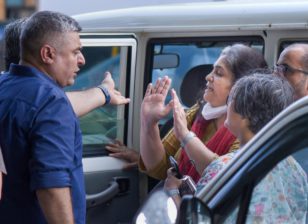India’s ‘Fake News’ Crackdown Crumbles Over Journalists’ Outrage

By Kai Schultz and Suhasini Raj
NEW DELHI — The Indian government called the decree a crackdown on fake news. It lasted less than a day.
On Monday evening, the Ministry of Information and Broadcasting abruptly announced that it would penalize journalists who spread “fake news,” the term popularized by President Trump to disparage what he has regarded as unfair coverage of his 2016 American presidential campaign and first year in office.
The term is now widely used around the world by authoritarian politicians and governments to describe reporting that they find objectionable.
Members of India’s freewheeling press expressed shock and outrage at the announcement, seeing the hidden hand of Prime Minister Narendra Modi — who enjoys warm relations with Mr. Trump — to quell negative media coverage ahead of India’s general election next year.
Within hours of the reaction, Mr. Modi’s government annulled the announcement without explanation on Tuesday morning. “Press Release regarding Fake News uploaded last evening stands withdrawn,” the Ministry of Information and Broadcasting said on its website.
The U-turn was welcomed by free-press advocates who worry about what they see as a global threat in the guise of prohibitions on news deemed by governments to be false. Malaysia’s lower house of Parliament just approved a measure threatening spreaders of “fake news” with prison sentences.
But some Indian journalists said the original announcement might have been meant to test the tolerance of news media outlets for more restrictions. They noted that journalists critical of leaders from Mr. Modi’s Bharatiya Janata Party had been under pressure since the party came to power in 2014.
The original announcement said journalists found to have written or broadcast “fake news” would lose their official accreditation.
“Make no mistake: this is a breathtaking assault on mainstream media,” Shekhar Gupta, a prominent journalist, wrote on Twitter before the amendment was withdrawn.
The penalties in the original announcement did not apply to independent or partisan digital media outlets, some of them regarded in India as major disseminators of fake news. These platforms are not regulated by the two main media regulatory bodies, the Press Council of India or the News Broadcasters Association. Instead, the rules would have been felt primarily by large, established outlets.
In its original announcement, since taken offline, the Ministry of Information and Broadcasting said that guidelines for the accreditation of journalists were being amended to counter “increasing instances of fake news in various mediums.” The statement did not define fake news or provide guidelines about who could lodge complaints against journalists.
The statement said a journalist’s accreditation would be revoked for six months after a first violation, one year after a second violation and permanently after three violations. It also said that once a complaint against a journalist was registered, his or her accreditation would be suspended until a determination had been made.
An accreditation is not required in India but is regarded as critical for access to news makers. Accredited journalists in India face fewer security clearances when visiting government offices and are eligible for subsidized train travel, among other benefits.
Smriti Irani, who runs the Ministry of Information and Broadcasting, had said on Twitter that complaints against journalists would be handled by the Press Council of India and the News Broadcasters Association. She said neither body was controlled by the government.
Rajat Sharma, the president of the News Broadcasters Association, said that his group had not been consulted before the announcement on Monday. M. V. Shreyams Kumar, the vice president of the association, called the announcement “ridiculous.”
“This whole exercise is to curb the freedom of the press,” Mr. Kumar said.
Ms. Irani, after arguing the measure’s merits on Twitter with journalists and opposition figures, was taking a more conciliatory tone by midday Tuesday, inviting journalists to meet with her and provide “suggestions so that together we can fight the menace of ‘fake news’ & uphold ethical journalism.”
Raj Kamal Jha, the chief editor of The Indian Express, said, “Of course, fake news pollutes public discourse but whose fake news is it anyway?”
“Spin, cheap shot, empty boast, outright lie, innocent mistake, an oversight — who gets to decide what’s fake, what’s not?” he continued. “That’s why the government’s order last night using fake news as an excuse to punish journalists was an assault on the freedom of the press.”
The Indian Express reported on Tuesday that at least 13 government ministers, including Ms. Irani, had tweeted a link to an article claiming to have exposed “four major fake news stories.” The article, on a website called The True Picture, accused “sections of the media” of supporting the opposition and trying to portray the government and the Bharatiya Janata Party in a bad light.
The Indian Express reported that the website shared a phone number with a company involved in publishing a children’s book written by Mr. Modi. Employees of the company, Bluekraft Digital Foundation, said they did not run the website.
Refrence: https://www.nytimes.com/2018/04/03/world/asia/india-fake-news.html


